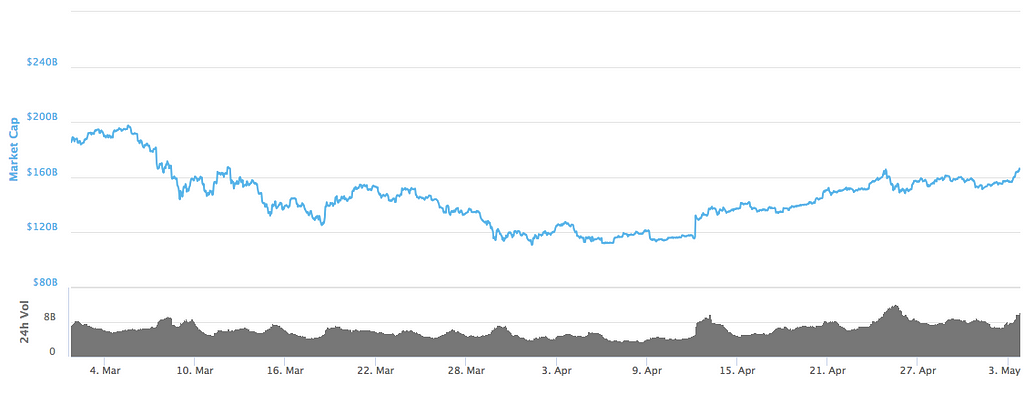Latest news about Bitcoin and all cryptocurrencies. Your daily crypto news habit.
This bear market has been absolutely killing us for a while now.
Since the Coin and Crypto team spends so much time looking at cryptocurrency charts, we decided to share some of the data from the March- April bear market with you.
As an investor, you need to know when to buy and when to hold. So we decided to answer one critical question — which type of cryptocurrency best survives a bear market?
Let’s find out.
We will look at each main type of cryptocurrency and the specific coins in that category.
The Case Study
Disclaimer — this is just an interesting dive into the topic and does not constitute legal advice. Invest at your own risk.
Let’s begin.
The general types of cryptocurrencies are privacy coins, stores of value, true currencies, platforms, utility tokens, and security tokens.
The bear market we will be looking at is from the beginning of March to the beginning of May, the longest bear market we have seen in 2018.
First, what happened in the market at large? Below is the total market cap across all coins. This is the baseline will will compare against.
 Total Market CapCase Study #1: Privacy Coins
Total Market CapCase Study #1: Privacy Coins
Privacy coins are the type of cryptocurrency that is seeking to make transactions private. Through different processes, these coins are able to hide the identity of senders/receivers and the details about a transaction.
How well do privacy coins survive a bear market? Let’s investigate it using Monero (XMR) and Dash (DASH) as examples, since they are two major privacy coins.
Monero (XMR) Chart From March to May
Dash (DASH) Chart From March to May
These charts look so eerily similar, it’s kind of unbelievable.
We see both Monero and Dash get hit pretty hard in mid-April, and bounce back well come the beginning of May.
For their ability to survive a bear market, they do pretty well. However, these definitely aren’t for the investors with weak hands, as the low in the middle there is pretty scary to them. Buying the dip would have done investors pretty well during this bear market.
Case Study #2: Store of Value Coins
Stores of value are things that keep their value for a long time. Gold and agricultural land have long been considered real-world stores of value. Cryptocurrencies fit in because they are “inflation-proof.”
Bitcoin (BTC) is the most prime example of a store of value, with Ethereum (ETH) supplementary to it. We’ll use these two as an example for the store of value coins.
Bitcoin (BTC) Chart From March to May
Ethereum (ETH) Chart From March to May
These two charts actually look really similar also!
We see a slow, steady drop from March to mid-April. Store of value coins appear to be a lot less volatile than many of the other coins. It’s possible that the brand value alone keeps these two at a respectable value throughout the bear market, meaning the “stores of value” are doing their jobs.
Ethereum bounces back to about where it came into the bear market, with Bitcoin not too far off of that mark.
Stores of value seem pretty well suited to survive bear markets, and while there are no real big dips to buy, they make for safe holds during these times.
Case Study #3: True Currencies
True currencies are cryptocurrencies with low transaction fees and high scalability, great for use in day-to-day transactions.
The two true currencies we will use as examples are Litecoin (LTC) and Ripple (XRP).
Litecoin (LTC) Chart From March to May
Ripple (XRP) Chart From March to May
These are the first two charts to look completely different from one another.
With Litecoin, we see a pretty sharp drop, followed by gradual increase to a point still pretty far from the start.
With Ripple we see a chart that looks pretty similar to that of Bitcoin and Ethereum. There’s no real steep drops, and a pretty strong and steady recovery.
The true currencies appear to be a mixed bag, and probably should be looked at on a case by case basis. This is likely because many of the true currencies are doing something completely different from one another.
Case Study #4: Platforms
Platforms are blockchains that other coins build on top of via an ICO. Ethereum is the first, and biggest, example of a platform. However, since Ethereum fits better into stores of value, we won’t use it here.
To investigate the effects of a bull market on platforms, we will use Stellar Lumens (XLM) and Qtum (QTUM) as examples.
Stellar (XLM) Chart From March to May
Qtum (QTUM) Chart From March to May
Woah, these charts are interesting!
There are a lot of peaks and valleys in both of these. We see pretty big dips at multiple points for both Stellar and Qtum.
However, both coins have good bounces when the market turns around. Qtum bounced back to about where it started, and Stellar even well exceeded its starting point.
Overall, we see a lot of volatility, but they both survive pretty well.
Case Study #5: Utility Tokens
Utility tokens are used as for a specific purpose on a platform. You can think of them like currencies on applications.
The two utility tokens we will use as examples are Tron (TRX) and Basic Attention Token (BAT).
Tron (TRX) Chart From March to May
Basic Attention Token (BAT) Chart From March to May
We see quite a bit of volatility within both of these charts.
With Tron, there is a lot of volatility early on in the bull market. First, it dips quickly and recovers, then dips again. However, the recovery for Tron is strong, bumping it well above where it started.
With Basic Attention Token, the decline is a bit steadier. It has a hard time keeping the bounce backs upon hitting resistance (multiple times), putting it about where it started the bear market.
Both of these coins make it out of the bear market well, after a bumpy ride along the way.
Case Study #6: Security Tokens
Security tokens are different from utility tokens. Security tokens get their value from expectation of value increases. In one such example, NEO rewards users with GAS (another token) for having it. While NEO is also a platform, this makes its asset a security token.
We will use NEO (NEO) and PIVX (PIVX) as examples of security tokens, though both fit into other categories also.
NEO (NEO) Chart From March to May
PIVX (PIVX) Chart From March to May
Both of these had some fairly volatile periods during the bear market.
NEO had a pretty steep drop during late March, followed by a jump and a more steady drop afterwards.
PIVX had a more soft drop and a pretty level overall price during the bear market.
Both coins saw steady rises once the bear market came to an end.
Conclusions
As we saw above, there are some coins that survive bear markets better than others.
Privacy coins have a big dip then bounce back.
Store of value coins hold their value best during the downturn, but lack the big rebound.
True currencies are unpredictable.
Platforms, utility, and security tokens are the most volatile, but also have the biggest bounce back when the market turns around.
There are lots of good investment opportunities in cryptocurrency, but there will definitely be bear markets. Being mentally prepared for what comes with the bear market can make the difference between winning and losing.
If this article was helpful or interesting, please hit the clap button 👏 and if you know someone that would like it — feel free to share it.
We will be sure to deliver you more analyses of the market in the weeks to come. — writers@coinandcrypto.com
Spotlight on the crypto bear market: how to best survive was originally published in Hacker Noon on Medium, where people are continuing the conversation by highlighting and responding to this story.
Disclaimer
The views and opinions expressed in this article are solely those of the authors and do not reflect the views of Bitcoin Insider. Every investment and trading move involves risk - this is especially true for cryptocurrencies given their volatility. We strongly advise our readers to conduct their own research when making a decision.














